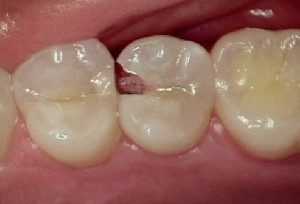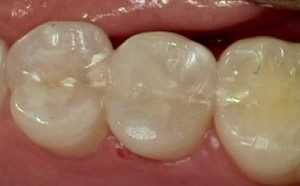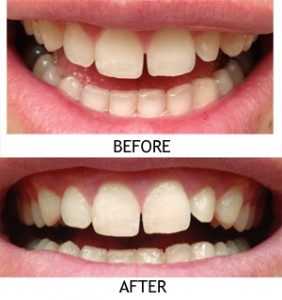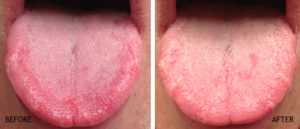I’ve had several of my patients ask about oil pulling and cavities. Here’s the bottom line up front: oil pulling will not reverse the effects of tooth decay, and it is not fully effective at cleaning bacteria from the mouth. I do not recommend oil pulling as a replacement for traditional home care and regular check-ups. Oil pulling can be a beneficial addition to traditional home care.
What is oil pulling?
Oil pulling is swishing with about a tablespoon of oil for up to 20 minutes. Coconut oil, sesame oil, or sunflower oil have been used. Put a tablespoon of oil in your mouth and swish – pushing and pulling the oil around and between the teeth. The oil will come into contact with the teeth and gums, the tongue and roof of the mouth, and the inside of the lips and cheeks.
Oil pulling originated in the India region thousands of years ago. It has been used in the U.S. for oral home care since the 1990s.
In order to give an informed opinion about oil pulling, I tried it myself for two weeks. I used daily oil pulling at bedtime as my only means of oral hygiene. I did not use a toothbrush, toothpaste, or mouthwash (other than oil pulling) for these two weeks. I did not floss for these two weeks. I used only coconut oil pulling for 100% of my oral care for two weeks. Read about my experience below. This is my personal experience only, as viewed through the lens of a dentist.
How does oil pulling work?
Have you ever mixed water and cooking oil in a glass? They separate into two separate layers. Water molecules and oil molecules repel each other. Water is lipo-phobic (afraid of fat) and oil is hydrophobic (afraid of water). You cannot dissolve oil into the water.
Bacteria in our mouth live in plaque. Plaque is a soft protein layer created by the bacteria. Plaque is hydrophobic, which is one of the reasons it can stick to teeth. Plaque cannot be rinsed off the teeth with water. If plaque were lipophobic like water, then water would rinse it away.
Oil pulling removes bacteria from the mouth by rinsing off plaque and bacteria. Both the oil and plaque are hydrophobic, so they will mix. The long rinse period of 20 minutes allows for more and more bacteria to be rinsed from where it is attached, mixing with and dissolving in the oil. By the end of 20 minutes, a large percentage of the bacteria is removed (or “pulled”) from the teeth, gums, tongue, and other oral tissues. The plaque and bacteria are spit out with the oil. Spit into a trash can - not down a drain, as this may block your drain pipes when the oil cools and solidifies.
Some claim that the oil changes from clear to white by the end of the 20 minutes because of all the toxins that have been dissolved in the oil. The white appearance may be bacteria and plaque debris, or it may be the emulsification of saliva into the oil, i.e. bubbles.
(While some research shows that the lauric acid in coconut oil is antibacterial, I’m not convinced that it has a specific effect against strep mutants, the main bacteria that cause tooth decay. If any type of bacteria is in the trash can instead of my mouth, that is good enough for me.)
One goal of oral hygiene is to remove bacteria. Traditional home care removes bacteria by the friction of a toothbrush and floss. Toothpaste increases friction with mild abrasives. Besides fluoride’s main benefit of hardening the tooth against cavities, fluoride also has an antibacterial effect.
If oil pulling can remove bacteria, then it is a useful oral hygiene method.
Oil pulling claims
Oil pulling claims to:
- REVERSE CAVITIES
- WHITEN TEETH
- DECREASE TEETH SENSITIVITY
- IMPROVE GUM HEALTH
- DECREASE SINUS SYMPTOMS INCLUDING ALLERGIES
- DECREASE TMJ SYMPTOMS
- CURE BAD BREATH OR HALITOSIS
- CURE EAR ACHES
- IMPROVE IMMUNE SYSTEM
There are other claims that get a little more far-fetched, so I’ll focus on this list. (Published research on oil pulling is limited. I will not cite the research here. Though some research seems to stand up to scientific scrutiny, some of the researchers work for a group that sells sesame oil, thus creating a conflict of interest.) I will consider claims based on my education as a dentist and my two-week experience.
By reducing the number of bacteria in your mouth, oil pulling can prevent _cavities. Once damage from tooth decay has _already happened, the oil cannot reverse this damage. A tooth with a hole can only be repaired with a dental filling. If the hole is deep, then a root canal or a crown may be needed. Oil pulling cannot overcome this reality. There is no mineralizing agent in the oil that can remineralize a tooth. Even if it could, and remineralization of a tooth is only beneficial in the very early stages of tooth decay – well before cavitation occurs.
Can oil pulling correct this type of cavity?


Of course not. This hole in a tooth will need traditional dental care, such as a filling. There is nothing about the oil in oil pulling that would replace lost tooth structure. These photos show before and after of a cavity replaced by composite, an artificial filling material commonly used by dentists to repair teeth damaged by cavities.
Teeth may appear whiter with oil pulling by removing stains and improving the health of the gums. Healthy, pink gums may create greater contrast for the teeth to appear whiter. Oil pulling does not whiten the teeth as hydrogen peroxide products do. I wondered if whiter teeth was a placebo effect. Did teeth really get whiter? In my own experiment with oil pulling, I used the shade guide from my office for a more objective measurement of whitening. Before oil pulling, my teeth were between VITA A1 and A2 shades… let’s call it VITA A1.5. After two weeks of oil pulling, my teeth were a VITA A1 – a half shade improvement. This is minimal. It’s unlikely that anyone would notice that difference in my smile. A traditional tooth whitening with peroxide products will improve four shades or so in the same two week time period.
Here is a before and after photo of my teeth for teeth shade reference. Both photos were taken in similar lighting with no post-photo retouching.

Tooth sensitivity is often caused by exposed dentin. It’s possible that toothbrush and toothpaste friction may keep this dentin exposed, though most people find sensitivity relief from sensitivity toothpaste. Oil pulling removes bacteria from the teeth with much less friction and may reduce sensitivity in this way. It's possible that oil residues may block pores in the dentin, covering nerve endings, and thereby reducing sensitivity.
Gum disease is caused by bacteria. It is reasonable to expect gum health to improve when bacteria are reduced by oil pulling. Oil pulling may have benefits to gum health similar to benefits from a mouthwash. However, oils may only penetrate two or three millimeters into the gingival sulcus. If you have advanced gum disease with five-millimeter pockets or deeper, you should have treatment beyond what oil pulling can offer.
There is no direct opening between the mouth and the sinus, though the upper back teeth have roots very close to the sinus floor. It’s possible that reducing bacteria in the mouth may reduce the overall burden on the immune system, causing an improvement of sinus and allergy symptoms. Of the claims in this list, I think this claim has the weakest connection to oil pulling benefits.
Some patients with TMJ symptoms cannot tolerate holding a rinse in their mouth for 20 minutes. If your jaw is tired when oil pulling, slow down and relax. Other patients report an improvement of TMJ symptoms. The gentle swishing action may act as physical therapy for these patients, relaxing jaw muscles. Due to grinding my teeth in my sleep, I occasionally suffer from tight jaws and sore jaw muscles. I happened to have an episode of soreness begin just before the oil pulling experiment. The soreness in my jaws did not worsen or improve for the first 10 days of oil pulling. In the last four days, the soreness improved slightly but did not go away completely. I personally do not attribute any connection between my TMJ symptoms and oil pulling.
Bad breath, or halitosis, is most often linked to bacteria that live in crevices of the tongue. Oil pulling may help bad breath by reducing the bacteria that hide on the surface of the tongue.
Here are before and after photos of my tongue. Both photos show signs of geographic tongue, harmless spots on the tongue. The after photo may have more coating, as I usually include tongue scraping in my oral hygiene routine, but did not do any tongue scraping during the two-week experiment. If tongue coatings increase with oil pulling, this may increase the risk of bad breath. I didn’t notice a change in my breath, and my wife said oil pulling had a neutral effect on my breath: it was not bad nor unusually fresh.

It’s possible that oil pulling can help earaches. The eustachian tube is an opening between the throat and the middle ear. While it is unlikely any oil will have direct access to the eustachian tube or the ear, the motion of swishing with oil may relieve pressure in the ear in the same way yawning does during airplane descent.
Does oil pulling aid the immune system? It’s possible. The immune system is a limited resource. If oil pulling reduces the bacteria and inflammation in the mouth, the resources of the immune system are freed up to help in other areas.
Why traditional home care is still recommended
Oil pulling reduces bacteria, but not as well as brushing and flossing. With no home care at all (no brushing or oil pulling), the plaque would be present after 7 days and an increase in calculus after 10 days. Gingivitis would be present after 7 days. By doing a 14 day, oil-pulling only home care experiment I could evaluate if oil pulling would prevent plaque accumulation, calculus, and gingivitis.
On day seven I noticed plaque around three of my front teeth. I thought the oil pulling wasn’t working. The next two nights I focused on rinsing the oils around the front teeth more, and then the plaque was gone. After my 14-day experiment, I asked my hygienist to check the health of my teeth and gums. She saw some plaque around two molars. This leads me to conclude that practice, experience, and thoroughness are important with oil pulling. There is a small learning curve to doing oil pulling effectively.
One night I missed an oil pulling session, so I made it up the next morning. I was surprised to see redness along with many areas of the gingiva. Gingivitis set in rather suddenly when I missed a session.
My hygienist also noted a couple of areas of gingivitis and bleeding on probing. She expected the state of my mouth to be much worse without brushing for two weeks. Oil pulling is effective at reducing plaque and gingivitis, but not completely. Because it may not 100% effective, I do not recommend it as a complete replacement for brushing and flossing.
I had some calculus between the lower front teeth. It did not seem to increase or decrease during the 14-day experiment.
I have three amalgam fillings that were not affected during the two weeks of oil pulling.
I have a geographic tongue that continued about the same during oil pulling.
My oil pulling experience did not impress me to the extreme. While it does reduce bacteria, it doesn’t completely remove it with ease. I still recommend traditional oral care with a toothbrush, a fluoride toothpaste, and floss.
Daily oil pulling may help oral health. Also, oil pulling may also be beneficial on a one-time basis the day you have an appointment for oral surgery or when getting your teeth cleaned.
